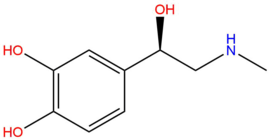Adrenaline: Difference between revisions
>Dextromethorphan |
>Dextromethorphan |
||
| Line 6: | Line 6: | ||
==Chemistry== | ==Chemistry== | ||
[[File:Monoamine_chain.png| | [[File:Monoamine_chain.png|210px|thumb|right|Skeletal formula of monoamine chain molecule.]] | ||
[[File:Pyrocatechol1.png| | [[File:Pyrocatechol1.png|210px|thumb|right|Skeletal formula of catechol molecule.]] | ||
Adrenaline is a [[phenethylamine]] and catecholamine monoamine, which is a monoamine chain attached to a benzene ring. The catechol ring is a benzene ring with two hydroxyl groups attached to it, where both are ortho-oriented relative to each other. A monoamine chain is made up of an amine group attached to an ethane chain. This monoamine chain can be found in many neurotransmitters, including [[histamine]], [[dopamine]], [[serotonin]] and [[noradrenaline]]. It's also found in many drugs, examples being [[tryptamines]] and [[phenethylamines]]. | Adrenaline is a [[phenethylamine]] and catecholamine monoamine, which is a monoamine chain attached to a benzene ring. The catechol ring is a benzene ring with two hydroxyl groups attached to it, where both are ortho-oriented relative to each other. A monoamine chain is made up of an amine group attached to an ethane chain. This monoamine chain can be found in many neurotransmitters, including [[histamine]], [[dopamine]], [[serotonin]] and [[noradrenaline]]. It's also found in many drugs, examples being [[tryptamines]] and [[phenethylamines]]. | ||
Revision as of 21:01, 24 October 2016

Adrenaline, also known as epinephrine, is a hormone and monoamine neurotransmitter. Adrenaline is primarily produced in the neurones of the central nervous system of animals including humans.
It is used to regulate heartrate, blood vessel and air passage diameters, and metabolic shifts. Adrenaline release is a crucial component of the fight-or-flight response of the sympathetic nervous system.
Chemistry


Adrenaline is a phenethylamine and catecholamine monoamine, which is a monoamine chain attached to a benzene ring. The catechol ring is a benzene ring with two hydroxyl groups attached to it, where both are ortho-oriented relative to each other. A monoamine chain is made up of an amine group attached to an ethane chain. This monoamine chain can be found in many neurotransmitters, including histamine, dopamine, serotonin and noradrenaline. It's also found in many drugs, examples being tryptamines and phenethylamines.
The adrenergic system
The adrenergic receptors exhibit both excitatory and inhibitory neurotransmission and are located throughout the human body. There are two types of adrenaline receptors; α(1 or 2) and β(1-3).
Drugs targeting the adrenergic system
- Direct-acting agonists
Direct-acting agonists have direct action upon the adrenergic system where they have action upon the adrenergic receptors themselves. These include antihypertensives (to reduce blood pressure), sedatives and muscle relaxants.
- Indirect-acting agonists
Indirect agonists work by increasing the neurotransmission of endogenous chemicals such as adrenaline or noradrenaline. These include many stimulant drugs, such as amphetamine, cocaine, MDMA and methylphenidate.
- Antagonists
Antagonists of the adrenergic system can be split into α-blockers and β-blockers. These include anti-psychotics, anti-depressants and in medication preventing heart attacks.
See also
References
 |
This article does not cite enough references. You can help by adding some. |